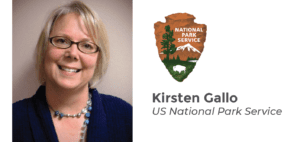[webinar] Radical Transformational Leadership for Protected Areas & Climate Change
Radical Transformational Leadership for Protected Areas & Climate Change
- 18th May 2020
- 15:30 CEST
- Participation is free, register here: webinartransformationalleadership.gr8.com/
Climate, society, natural spaces: the world is calling for a meaningful change. Europe´s protected areas know the urge to adapt, but these transformations depend on our capacity to design approaches that can shift the status quo. As in our last EUROPARC webinars on climate change (check here and here), we looked at practical tools & methodologies for Parks, in this webinar, we invite you to look at the personal dimension of transformation.
Radical Transformational Leadership is a set of tools and templates that allow us to tackle complex problems, including climate change and conservation of natural protected areas. The framework was developed over the last three decades by Dr. Monica Sharma and her team and tested world-wide in the healthcare and human rights sectors. Through this webinar, we introduce the environmental applications of the framework, with first-hand experiences from the USA and Spain.
Our special guests show us environmental applications of the Radical Transformational Leadership framework and illustrate how it can help us develop meaningfully our work in protected areas.
Marta Múgica from EUROPARC Spain will open the session, to show us the importance of sharing knowledge among Protected Area professionals, for co-adaptation to climate change. Kirsten Gallo from the US National Park Service will present her work in natural parks based on Transformational Leadership framework, over the last 10 years, while Conchi Piñeiro from Altekio (ES) will present her recent experience as trainee and early applications of this work to climate change.
The webinar, co-organised with FUNGOBE and EUROPARC Spain, will be held in English and moderated by Bárbara Pais. We aim for a truly interactive experience, so do join us with your camera and microphone.
Kirsten Gallo, US National Park Service
When Kirsten Gallo was a little girl, she wrote a letter to the deer and bunnies in her back yard promising to always take care of them. Decades later, she is taking care of deer, bunnies and so much more as the head of the U.S. National Park Service Inventory and Monitoring Division. She held a variety of positions in the U.S. Forest Service and the National Park Service conducting natural resource monitoring and stewardship of public lands. She holds a doctorate degree in Ecology and has dedicated her career to conserving natural resources and demonstrating interdependence between humans and our environment using transformational leadership techniques.
Conchi Piñeiro, Altekio
Conchi Piñeiro is passionate about how individual, collective and societal changes are interlinked especially in relation with nature. That’s why as group facilitator in Altekio, she enables groups and organisations to find creative ways to respond to our challenges such as climate change, in order to achieve an eco-social transformation. She is also a researcher and trainer on Sustainability, with a PhD in Environmental Education.
Chalk Bed Marine Conservation: lessons from the UK
A case study from the Cromer Shoal Chalk Beds Marine Conservation Zone (MCZ), featured in our latest Protected Areas In-Sight Journal, that is available in English, German and French.
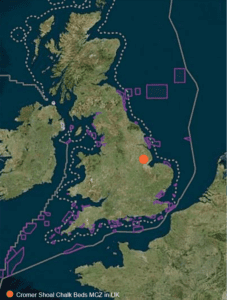
Cromer Shoal Chalk Beds MCZ in UK. Copyright JNCC.
Article issued by Fiona Tibbitt – Marine Lead Adviser at Natural England
Natural England (NE) provides conservation advice to regulators of fishing activities in English waters, with a special focus on Marine Protected Areas.
Cromer Shoal Chalk Beds MCZ in North Norfolk was designated in 2016 under UK legislation The Marine and Coastal Access Act (MACAA) of 2009. The aim of MACAA 2009 is to protect rare, threatened and representative habitats, species and geological features of national importance. This legislation is unique – it considers ecological and geological importance as well as socio-economic impacts. Local communities and sea bed users had a say in the designation process and those views were listened to. A decade later, we are much closer to a well-managed, ecologically coherent network of Marine Protected Areas, but there’s still work to do.
Chalk beds are important because their cracks and crevices provide refuge for wildlife, especially juvenile invertebrates and fish. It is also a source of substrates for burrowing organisms. Any irreparable structural damage is therefore significant and may require some sort of management.
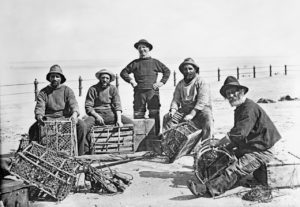
Historical Cromer Crab and Lobster fishery.
Copyright National Maritime Museum
The assessment of fisheries impact to create management measures in Cromer Shoal Chalk Beds MCZ is now underway. But when the site was designated, we had limited evidence. Fisheries activity levels were unclear and the position of Natural England (NE) was that the most intensive fishing activity – ‘potting’ – was small scale, selective and low impact. Based on the best available evidence at that time, implementation of management measures was unlikely and this was communicated widely.
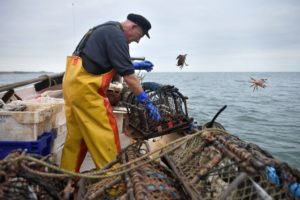
Cromer Crab and lobster fishery today. Copyright Romsey Advertiser.
Currently, new anecdotal evidence shows that there may be impacts on chalk habitats from some fishing activities after all. But given the rarity of this habitat, we still need more evidence to improve our understanding.
Chalk Bed Marine Conservation: reconciling the regional heritage with sustainable management
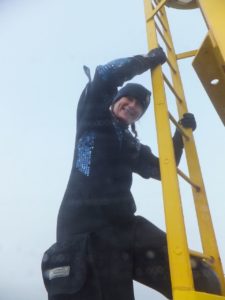
Fiona Tibbitt
The crab and lobster fishery started in the 19th century and is fundamental to the character, cultural heritage and economy of North Norfolk, so it is essential that any management is risk-based and proportionate. The application of the ‘precautionary principle’ is required where evidence is lacking and NE advise an ‘adaptive management approach’. This means, with more evidence, management can be modified accordingly.
NE are working closely with the conservation authorities and the Agents of Change Project, Marine Conservation Society at the Essex University, fisheries representatives and Seasearch to gather more evidence. We have conducted dive and drone surveys, workshops and discussions to improve understanding of activities and impacts on chalk. Novel techniques are being used, e.g. 3D Photogrammetry to improve our scientific understanding and provide tools for exciting marine visualisation opportunities for education and outreach purposes, such as Virtual underwater tours.
Community Voice Method workshops with fishers outlined plans for more to be done in terms of gathering evidence and communicating the findings. Plans for a fishers and regulators forum are evolving so fishers are included in the management and feel a sense of ownership. Local communities also need to be involved as they can act as local monitors, and resources for enforcement will always be finite.
The Community Voice Method is an innovative, research-based approach to fostering effective public conversations about important local issues. It aims to foster more inclusive, informed, and ongoing civic dialog in communities facing changes to their landscapes and resource-based livelihoods.
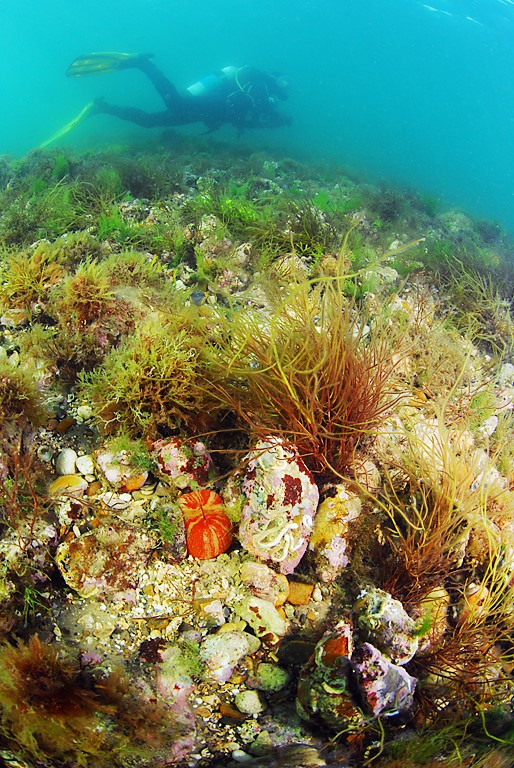
Diver on Cromer Shoal MCZ. Copyright Sam Bean.
Further work to help build trust between us and the local community is needed with better and regular communications. Sustainability is at the heart of management of Marine Protected Areas but both the marine environment and coastal communities need to be addressed, so they can thrive together.
This approach is being watched closely by others as there are implications for other chalk sites elsewhere. It will be precedent setting and we need to get it right.
So can we consider it a success?
We have achieved adaptive, proportionate and effective management. There is a thriving and sustainable local fishery with other sustainable marine activities and an engaged local community protecting their MCZ for future. With our partners, we help gather science and evidence to assess the condition of our MCZ in order to better inform the management and help to modify it accordingly. Finally, the public are engaged in innovative ways so they connect, value and respect the Cromer Shoal Chalk Beds MCZ. There’s still much work to do, but we’ll get there.

Fiona Tibbitt – Marine Lead Adviser, Natural England
[webinar] Sustainable Tourism in Protected Areas: the experience of CEETO project
Sustainable Tourism in Protected Areas: the experience of CEETO Project
- May 8th 2020
- 11:00h CET
- Participation is free, but registration is needed: https://ceetowebinar.gr8.com/
The Central Europe Eco-Tourism: tools for nature protection (CEETO) Interreg project ran for three years, to test innovative governance models for tourism development in Protected Areas. Integrating environmental, social and economic aspects, several solutions were implemented in protected areas in Austria, Germany, Croatia, Slovenia and Italy, with the aim to make tourism a real driver for nature protection and local economic and social well-being.
In this webinar, we will hear some of the best examples of the project implementation, and get access to relevant tools for Protected Area Managers and policy-makers. From Slovenia, we will hear the importance of integrating buffer zones in the management of tourism, and from Italy, we will have a technical insight into a new visitor monitoring tool.
Programme:
1) The CEETO project, an overview
Learn how CEETO project has contributed to the development of Sustainable Tourism in European Protected Areas, its goals, structure and main outputs.

By Mauro Generalli – CEETO Communication and Technical Manager at Emilia-Romagna Region – Protected Areas, Forestry and Mountains Development Department
2) The Importance of Buffer Zones: Working with Public Authorities and Privates 12 min
As part of the activities within the CEETO project, a common strategy to foster the development of sustainable tourism in the protected area was developed during a participatory process including public authorities and privates. A buffer zone has been identified as an important tool to mitigate the impact of tourism on protected areas.

By Robert Smrekar, L.L.M. – Director of the Public Institute Landscape Park Strunjan, Slovenia.
As a lawyer with vast experience in civil and public law, has been able to identify all the necessary legal aspect of the integration of buffer zones in the communication process with various stakeholders, especially regarding spatial planning and required regulation changes.
3) Nirano’s Mud Vulcanos: Identifying visitor’s profile with artificial intelligence.
In the framework of CEETO project, a Video Content Analysis (VCA) system – called NEMOS (Nature rEserve MOnitoring System) – was deployed and tested in the Integral Protected Zone of the “Salse di Nirano” Nature Reserve, Italy. By using Artificial Intelligence, NEMOS system records and provides spatial and temporal information on number of persons, vehiles and animals, density maps of the routes (heat maps) and record of events of trespassing physical barriers. This information is used to monitor the main threats existing in the Protected Area and develop mitigation measures accordingly.
 By Rudy Melli – CEO and Co-founder at Vision-e Srl, Italy, Head of the VCA system.
By Rudy Melli – CEO and Co-founder at Vision-e Srl, Italy, Head of the VCA system.
After two years at AImageLab, the Computer Vision and AI research group of the University of Modena and Reggio Emilia, working on international projects, he cofounded Vision-e: a start-up company focused on bringing these technologies at state of the art in the industrial and service fields with innovative solutions. His skills cover the understanding of images such as object detection, people tracking, face recognition; he also has strong experience in integrating these technologies to create intelligent embedded systems and industrial devices.
4) Tools for Sustainable Tourism planning and governance in Protected Areas.
CEETO project has also been a great source of knowledge from which different tools have been designed to facilitate the work of Policy Makers and Protected Area Managers in planning and implementing Sustainable Tourism. Get to know the following tools:
CEETO Manual for Protected Area Managers: a reference guide containing basic information and useful tools to development Sustainable Tourism.
 By Ana Krvarić – CEETO Project Coordinator at WWF Adria, Croatia.
By Ana Krvarić – CEETO Project Coordinator at WWF Adria, Croatia.
Ana is an expert in EU project management, with experience in cooperating with public and private sector in the process of strategic planning and implementation, as well as in the protected areas management. Since 2017, Ana is the project coordinator for the Interreg CEETO Project at WWF Adria.
CEETO Guidelines for Policy Makers: a compendium of the project results, examples and recommendations on how to gain more knowledge and reduce the impact of tourism.
 By Tina Primožic – CEETO Manager at Regionale development center Koper, Slovenia.
By Tina Primožic – CEETO Manager at Regionale development center Koper, Slovenia.
Tina Primožič graduated in geography. She joined RRC team as project Manager in 2011. Tina has experience in administrative and project management of EU projects oriented in planning at the sea and sustainable tourism and in preparing regional development plans. From 2017, she is responsible for the implementation of the project CEETO at the RRC Koper.
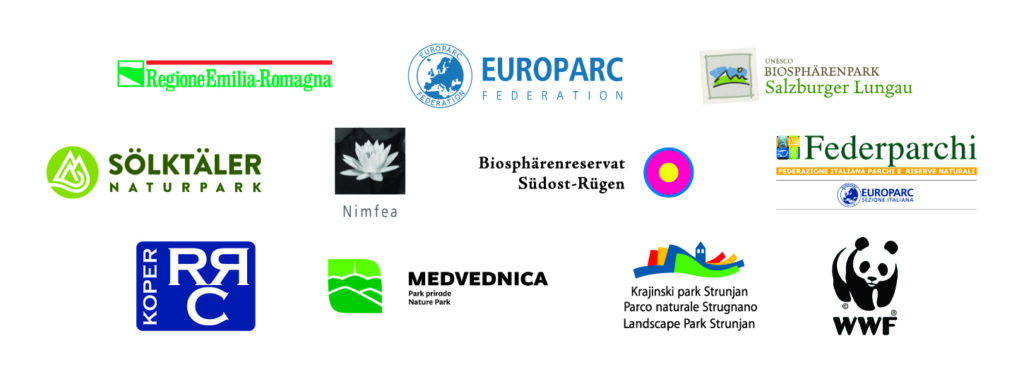
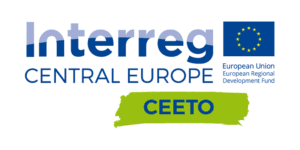
EUROPARC’s Support for the EU Green Deal
A letter to the European Union underlined EUROPARC’s support for the EU Green Deal and the important role Protected Areas play.
With a message to the president of the European Commission Mrs Ursula von der Leyen, the Executive Vice-President Mr Frans Timmermans, the President of the European parliament Mr David Sassoli and the Commissioner Mr Virginijus Sinkevičius, EUROPARC expresses full support to the EU Green Deal.
EUROPARC’s support for the EU Green Deal
We are strongly convinced that the vision expressed in the Green Deal is our life-line to a sustainable future.
If we want clean air and drinkable water for everyone. If we want a biodiverse and climate-neutral society. If we believe in justice and solidarity and if we would like to give a perspective to the future generations, for these reasons we give our full support to the EU’s Green Deal.
We are living in difficult times, but the Green Deal agenda should not be delayed, as the priorities foreseen are crucial to overcome the challenges ahead of us.
In this framework, EUROPARC firmly expresses the urgency for the approval of the EU Biodiversity Strategy 2030, a crucial pillar of the EU Green Deal. The increase of European surface protected, the promotion of specific initiatives for the restoration of habitats and ecosystems, together with targets for effective management of Natura 2000 sites and Protected Areas are all essential.
EUROPARC welcomes also the development of the EU Farm to Fork Strategy. This is another fundamental component of the EU Green Deal. The strategic vision and the power to integrate multiple policies, is a strong asset of the Green Deal. This is why EUROPARC and 18 other NGO’s joined the European Habitats Forum in sending a joint letter on biodiversity and the Farm to Fork strategy to President von der Leyen, Vice-President Timmermans and Commissioner Sinkevičius. Read the joint letter here.
Moreover, we support that Climate Policies remain high on the EU priority list.
The EU Green Deal has an enormous potential to transform our Europe. In order to fulfil its ambitions, it cannot remain a commitment on paper, but it should be applied concretely at European, national and local levels.
EUROPARC and its wide network of Protected Areas are ready and willing to play their role to contribute to implementing effectively the EU Green Deal strategies.
Read the entire letter supporting the Green Deal here (English) or here (French)!
